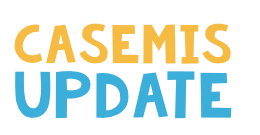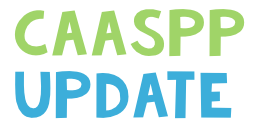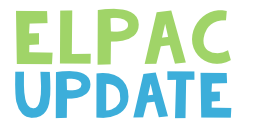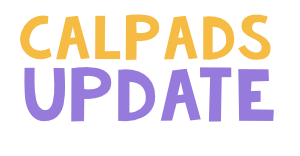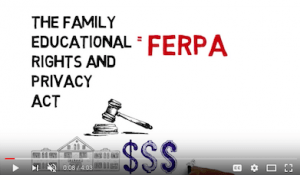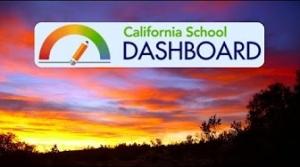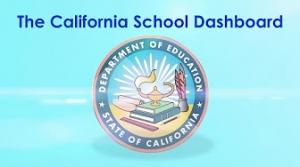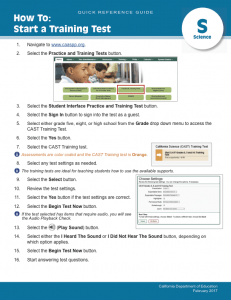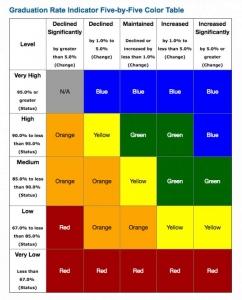(Editor's Note: I copied this directly from the PDF file that was distributed on the listserv. A few folks were having issues with the attachment not coming through, so here is the raw text:) California Department of Education – CALPADS Team and Special Education Division Subject: CASEMIS to CALPADS (C2C) TRANSITION UPDATES END-OF-YEAR (EOY) SUBMISSION CERTIFICATION DEADLINE MOVED TO AUGUST 25, 2017 Per the CALPADS Update Flash #129 that was released on July 21, 2017, the final August 11th EOY certification deadline (the close of the amendment window) for EOY 1, 2, and 3 has been moved to August 25th, in order to accommodate a defect fix. Special Education Local Plan Areas (SELPA...
Focusing on the California Assessment of Student Performance and Progress (CAASPP) System, including the Smarter Balanced assessments—a major component of CAASPP—and the California Alternate Assessments and science assessments. Accessibility Last month, the Smarter Balanced Assessment Consortium passed eight motions to update the Usability, Accessibility, and Accommodations Guidelines (UAAG). The changes, which apply only to specific CAASPP assessments, are as follows: New universal tools - Embedded thesaurus - Embedded line reader New designated supports - Non-embedded amplification - Embedded mouse pointer size and color New accommodations - Embedded braille transcript ...
The English Language Proficiency Assessments for California (ELPAC) Update, from the California Department of Education (CDE), is an e-mail for K-12 educators, including testing coordinators, which focuses on the English Language Proficiency Assessments for California. When the ELPAC is operational, it will replace the California English Language Development Test (CELDT). The ELPAC Update will be sent once per month beginning March 2017. Please forward this e-mail to any educators in your local educational agency (LEA) who would be interested in or benefit from this information. ELPAC Regulations Approved! Have you heard the news? The ELPAC regulations have been approved and will become effe...
The English Language Proficiency Assessments for California (ELPAC) Update, from the California Department of Education (CDE), is an e-mail for K–12 educators, including testing coordinators, which focuses on the English Language Proficiency Assessments for California. When the ELPAC is operational, it will replace the California English Language Development Test (CELDT). The ELPAC Update will be sent once per month beginning March 2017. Please forward this e-mail to any educators in your local educational agency (LEA) who would be interested in or benefit from this information. Superintendent's Designation of LEA ELPAC Coordinator Form Due August 1 Just a brief reminder: The Superintendent'...
(Editor's Note - From an email distributed today to all CA Accountablity Coordinators) Dear Accountability Coordinators: The purpose of this e-mail is to inform you of two important notifications announcing the opening of the 201617 End-of-Year (EOY) data submission to the California Longitudinal Pupil Achievement Data System (CALPADS). These notifications are attached and are also available online on the California Department of Educations Web site at: 201617 Data Collections: Mid-Year Update (May 5, 2017 Letter to Superintendents and Charter Administrators): http://www.cde.ca.gov/ds/sp/cl/data1617midyearupdate.asp CALPADS Update FLASH #127: http://www.cde.ca.gov/...
(Editor's Note: From an email from the CASEMIS listserv from earlier this week -Thanks Rose!) Dear County and District Superintendents and Charter School Administrators: REVIEW AND CERTIFICATION OF SPECIAL EDUCATION DISCIPLINE DATA IN THE CALIFORNIA LONGITUDINAL PUPIL ACHIEVEMENT DATA SYSTEM In the spring of 2015, the California Department of Education (CDE) began a process to align data collection processes for students with disabilities in California. This process ensures student data are accurate for the purposes of both monitoring and accountability, as outlined in the Individuals with Disabilities Education Act (IDEA) and the Every Student Succeeds Act (ESSA). In 2015–16, the coll...
CALPADS LEA ADMINISTRATOR AUTHORIZATION INTERIM PROCESS To implement best practices and enhance overall CALPADS security, the process for authorizing CALPADS LEA Administrators has been modified. If the CALPADS Administrator application on file at the California Department of Education (CDE) is over one year old, a new application is now required upon an LEA Administrator account password reset request. This process will continue until the completion of the 2017–18 End-of-Year (EOY) data submission, and will not begin this August as stated in the April 2017 CALPADS Information Meeting. A new process will begin with the rollout of the changes to the CALPADS security model and upgraded user in...
Coinciding with the May 9, 2017 CALPADS release, the following documents have been updated and are posted on the CDE CALPADS Web page at http://www.cde.ca.gov/calpads, under the System Documentation CALPADS File Specifications (v8.6) CALPADS User Manual (v8.5) CALPADS Error List (v8.9) CALPADS SSID and Enrollment Procedures (v8.6)CALPADS Data Guide (v8.6) CALPADS File Specifications v8.6 CALPADS Code Sets (v8.6) The CALPADS Code Sets document is provided in Microsoft Excel format and contains the current code values referenced in the CALPADS File Specifications (CFS) for the coded value data elements. The Code Sets document includes the Code Set Na...
The California Department of Education (CDE) is pleased to announce the availability of new features on the California School Dashboard (Dashboard) being field-tested this spring. These features include the reporting of local indicator data for local educational agencies (LEAs) that have submitted information through the self-reflection tools and the release of the Detailed Reports. To assist stakeholders, LEAs, and the public understand these new features, the CDE is hosting a Webinar on May 9, 2017, at 2 p.m. that will review these new features. The PowerPoint slides from the Webinar will be subsequently posted on the CDE California Accountability Model and School Dashboard Web page ...
KALAMAZOO, MICH. (March 2017) --- Level Data, a managed solutions company providing data integration solutions for school districts, has announced its Student SyncTM solution now serves more than 170 school districts throughout the nation, a 49 percent increase in a little more than a year. "It is an ideal fit for school districts looking to save time and money managing student accounts," shared Matt Betts, president of Level Data. "Student SyncTM automates the creation, deletion, and movement of student accounts, account properties, and home folders within a school's Active Directory, freeing Technology Directors and support staff to focus on their other responsibilities.". Leve...
Ever have questions about your rights regarding education records? This short video highlights the key points of the Family Educational Rights and Privacy Act (FERPA).
Here's an even better video explaining how the new California School Dashboard works and what it replaces. (And why this system is likely a better, more holistic approach to evaluating school progress). The video was created by two educators from Brea Olinda USD, who gave me permission to link to the video here on the site. Thanks Kerry & Erin!
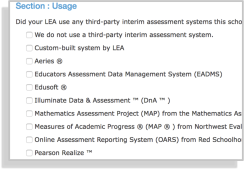
In my role as Director of Data & Assessment for Westchester Secondary Charter school I had the pleasure of supporting a research evaluation of the CAASPP/SBAC efforts underway in California. The Independent Evaluation Report was posted to CDE’s website today. You can find it at: http://www.cde.ca.gov/ta/tg/ca/caaspprptstudies.asp As an advocate for effective software systems and a participant in the study, I added my voice to the notion that the CDE should be looking much closer at existing 3rd party assessment systems. More than half of California's school districts have a 3rd party assessment system in place already, in ADDITION to the formative/summative resources available through CAASPP. The report explains in very understandable language the need to understand these 3rd party systems and the need to provide more integration resources to get data moving back and forth between systems. I also provided the investigative team with a list of known California assessment system providers. They incorporated that information into a survey (pictured above) which was distributed to school-site CAASPP coordinators (orange) and District CAASPP coordinators (blue). Though not a representative sample for state-wide assessment system adoption, it was interesting to see the results. Is the somewhat large discrepancies between what the schools are doing and what the districts are doing have any significance? Table source: http://www.cde.ca.gov/ta/tg/ca/caaspprptstudies.asp (Pages 45/46). A Note from Sunny Becker, one of the authors: This report includes results of our two 2016 studies: the CAASPP Smarter Balanced Interim Assessment Administration Study and the Access to Designated Supports and Accommodations Study. Many thanks to the representatives of Corona-Norco Unified, Fresno County Office of Education, Greenfield Union, Learning for Life Charter, Los Angeles Unified, Oakland Unified, Poway Unified, Salinas Union High, San Diego Unified, Tulare City, Victor Valley Union High, and Westchester Secondary Charter, who participated in one or both of these studies! Hooray Westchester Charter for helping to advance the assessment system conversation. Woot-woot!
March 20, 2017 Dear County and District Superintendents and Charter School Administrators: LAUNCH OF THE PILOT TESTS FOR SCIENCE The California Department of Education (CDE) is pleased to announce the launch of two new assessments for pilot testing, the California Science Test (CAST) and the California Alternate Assessment (CAA) for Science. These assessments will be available once your local educational agency (LEA) testing windows opens. Please note that students and schools will not receive results from the CAST and CAA for Science pilot tests. I encourage you to use this opportunity to begin the transition to the California Next Generation Science Standards (CA NGSS).&n...
Commitments for Funding Year 2016 Funding Year 2016. USAC is scheduled to release Funding Year (FY) 2016 Wave 39 Funding Commitment Decision Letters (FCDLs) on March 23. This wave includes commitments for approved applications for all service types and at all discount levels. As of March 17, FY2016 commitments total over $2.36 billion. On the date the FCDLs are issued, you can access your FCDL notification from the Notifications section of your landing page in the E-rate Productivity Center (EPC). How to Copy an FRN When completing the FCC Form 471, you can often save time by copying a Funding Request Number (FRN) from the same or another FCC Form 471. The form must exist in EPC so the FRN to be copied must have been created for FY2016 or FY2017 but the form does not have to be certified, as long as all of the information for the FRN you want to copy has been completed. To copy an FRN from the same or another FCC Form 471, follow these steps: Start your new FCC Form 471 in EPC. Provide the required data in the Basic Information and Entity Information sections of the form.When you reach the Funding Requests section, click the green Add FRN button.Create a nickname and answer the question, "Is this Funding Request a continuation of an FRN from a previous funding year?"Click the green Copy FRN button.To locate the FRN, you must search for either your FCC Form 471 application number or the FRN. If you do not have your form number or FRN, you can right-click the FCC Forms link on the left-hand menu, choose "Open Link in New Tab," and then perform a search to locate your form.After you identify the form or the FRN, you will then see a list of the FRN(s) you can copy. Check the box next to the FRN you want to copy and click the green Continue button.The system will then copy the FRN you chose. You must click the Refresh button to view the copied FRN in your current form.Review the copied FRN and make any necessary updates. Note that some information cannot be edited. Fields you can edit include:NicknameService type, but only if you delete all associated FRN line itemsContract, if you associated a contract with the original FRNCompetitive bidding information, if you identified the original FRN as tariffed or month-to-month (e.g., number of bids received, establishing FCC Form 470 number, service provider, pricing confidentiality). Keep in mind that the Copy FRN function is probably most useful for those applicants with a large number of FRN line items that are the same or very similar to those from another FCC Form 471. For applicants with only a few FRNs or FRN line items, it is probably easier to enter them manually. QDRs To Be Issued for Fourth Quarter 2016 At the end of each quarter, USAC issues a Quarterly Disbursement Report (QDR) to each billed entity if any invoicing activity occurred during that quarter. The QDR includes every FCC Form 472 (BEAR Form) and FCC Form 474 (SPI Form) for all funding years that were submitted to USAC and processed...
CAASPP Update Focusing on the California Assessment of Student Performance and Progress (CAASPP) System, including the Smarter Balanced assessments—a major component of CAASPP—and the California Alternate Assessments and science assessments. Accessibility Notes: Updated Guide Now Available! The updated Accessibility Guide for CAASPP Online Testing , which includes a change log (in the appendix), is now available on both the Student Accessibility Resources and Test Settings Web page and the Manuals and Instructions Web page of the CAASP Portal Web site. March System Downtime Begins Tonight Tonight at 5 p.m. through March 20 at 7 a.m., the Test Operations Management System, Test Administrator Interface, Interim Assessment (IA) Viewer, IA Hand Scoring, Online Reporting System, and the Appeal, Completion Status, and Roster Management systems will be undergoing system maintenance and will not be accessible. March 20—California Alternate Assessments and California Science Tests March 20—the opening of the CAASPP science and alternate assessments administration—is less than a week away! Are you ready? The high school grade-level assignment for the pilot California Science Test (CAST) and the pilot California Alternate Assessment (CAA) for Science can be confirmed by checking the assignment link on the CAASPP Portal CAST Web page . Confirm your CAA version assignments before you start printing out Directions for Administration (DFAs) or administer the CAA for English Language Arts and CAA for Mathematics. The new CAA for Science pilot test is a performance task (PT) assessment designed to be administered closer to the student’s instructional activity. This innovative assessment allows test examiners (TEs) some flexibility in the administration of the PT. TEs can select familiar materials for students and allow students to demonstrate what they know. A sample training test is available on the CAASPP Portal CAAs Web page . The training test is aligned with the grade five California Next Generation Science Standards but can be used by students in any of the tested grades to familiarize educators, students, parents, and stakeholders with the testing format of the pilot. This training test is the same type of embedded PT that will be administered during this year’s pilot CAA for Science. Designed to be administered one on one, the training test PT is nonsecure and for use in preparing for the pilot CAA for Science. Science Fact Sheets The California Science Test Pilot Assessment Fact Sheet is now available! It provides a quick and easy “Who, What, When, Why, and How” for the CAST as well as a timeline for implementation through to the operational assessment in 2019. A fact sheet for the California Alternate Assessment for Science will be posted soon. Please share this e-mail with any educators in your local educational agency who would be interested in or benefit from this information. To join the e-mail list, send a blank e-mail message to
To: Local Educational Agency Representatives From: California Department of Education - CALPADS Team Date: March 14, 2017 Subject: CALPADS Update FLASH #125 FALL 2 SUBMISSION DEADLINE The final Fall 2 amendment window closes on March 31, 2017. It is important for local educational agencies (LEAs) to certify the Fall 2 submission on or before March 31, 2017 in order to report their official staff full-time equivalent (FTE), English learner (EL) services, and student course enrollment data. CALPADS INFORMATION MEETING (CIM) IS APRIL 18 The spring CALPADS Information Meeting (CIM) is coming up on Tuesday, April 18, 2017. Registration for the CIM is open on the FCMAT/CSIS Events Web page at http://csis.fcmat.org/Pages/Events.aspx. Please register before Monday, April 17 at 11:00 am in order to receive logon information and meeting materials. If more than one person will be viewing the meeting together, please register only once and enter the name(s) of the other attendees where indicated on the registration form. SENR FILE TYPE CHANGES ON MAY 9 The collection of two new data elements, Golden State Seal Merit Diploma and State Seal of Biliteracy, will be added to the Student Enrollment (SENR) file type on May 9, 2017. All SENR batch jobs in the queue that have not been fully posted will be abandoned. LEAs will need to work with the student information system (SIS) vendor to make sure they have the ability to generate the new SENR extract that includes the two new fields. COLLECTION OF ATTENDANCE DATA FOR CHRONIC ABSENTEEISM (STAS) The Every Student Succeeds Act (ESSA) requires states to report chronic absenteeism rates for schools (Section 1111(h)(1)(C)(viii) of the ESSA). To meet this requirement, LEAs will be required to submit attendance data to CALPADS through a new file type, Student Absence Summary (STAS), in order for the state to calculate chronic absenteeism rates on a student-level basis. The State Board of Education is also considering chronic absenteeism as one of the indicators for state and federal accountability. The STAS data will be required for the first time as part of the 2016–17 End-of-Year (EOY) 3 - Student Discipline data submission. As part of EOY 3, LEAs will also be required to certify a cumulative enrollment count that is automatically calculated from the enrollment records posted in CALPADS. Please note that the absenteeism data collected through CALPADS will NOT replace the average daily attendance (ADA) data submitted to the California Department of Education (CDE) for purposes of funding the Local Control Funding Formula (LCFF), or other programs funded based on ADA, although to the extent possible, the same definitions will be used so that LEAs may utilize the data that they already collect. GUIDELINES FOR REPORTING LIBRARIANS As a result of the change related to Teacher Librarian reporting in 2015–16, the count of certificated librarians reported dropped drastically. One potential reason for the reduction is that LEAs may be reporting these staff incorrectly. Note: You can no longer use the Staff Assignment (SASS) record to report the Teacher Librarian as a...
Dear Accountability Coordinators: March 13, 2017 INFORMATION REGARDING THE UPDATED DATA FILES FOR THE DASHBOARD AND 5-BY-5 GRID PLACEMENT REPORTS On Wednesday, March 8, 2017, an e-mail was sent notifying that updates were made to: (1) the data files for the Suspension, Graduation, and English Learner Progress Indicators, (2) the California School Dashboard, and (3) the Five-by-Five Placement Reports. This is a follow-up to that communication to inform you of the specific revisions made and to notify you that the Academic Indicator will be updated by the end of the day. The specific updates are as follows: Suspension Rate Indicator: The local educational agency (LEA)-level data now exclude charter and alternative schools’ data. Prior to the update, the LEA-level data included these schools’ data. This update impacted most LEAs’ suspension rate data. Graduation Rate Indicator: The LEA-level data now exclude all alternative schools’ data. Prior to the update, only Alternative Schools Accountability Model (ASAM) schools’ data were excluded. The revisions now exclude both ASAM schools’ data and schools that meet the alternative school definition in the California Education Code (EC) (i.e., continuation, community day, opportunity, juvenile court, county community, etc.). This update impacted a limited number of LEAs only. English Learner Progress Indicator: Prior to the update, LEAs and schools received an automatic assignment of an Orange performance level if they did not test at least 50 percent of their annual California English Language Development Test (CELDT) test takers. The calculation of the 50 percent has been revised to include all CELDT test takers, not just annual test takers. This update reduced the number of schools that were assigned the Orange performance level. (There are no LEAs that received an assignment of an Orange performance level.) Academic Indicator:Determining the N size of “30 or more” for the Students with Disabilities (SWD) student group has been revised to be based only on students who have a valid primary disability code in the California Longitudinal Pupil Achievement Data System (CALPADS). Therefore, the SWD student group will receive a performance level (color) if the group has 30 or more students with a valid primary disability code in both the current and prior years of data. However, this student group also includes students who exited special education and have not received special education services for up to two years. These students are not used to determine the “30 or more” N size. But, both current and exited SWDs are included in the calculation for Status and Change. For example, a school that has 28 students with a valid primary disability code and two students who exited special education within the past two years would not receive a performance level because students with a valid primary disability code is less than 30. Because the N size is above ten, Status and Change will be reported based on all 30 students. This update reduced the number of SWD student groups that receive a performance level. If you have any questions regarding this e-mail, please contact the Academic...
FALL 2 COLLECTION WINDOW: DEADLINE REMINDER The final Fall 2 amendment window closes on March 31, 2017. It is important for local educational agencies (LEAs) to certify the Fall 2 submission on or before March 31, 2017 in order to report their official staff full-time equivalent (FTE), English learner (EL) services, and student courseenrollment data. CHANGES TO THE CALPADS DIRECT CERTIFICATION EXTRACT On March 7, 2017, CALPADS will stop using status code “Other” (represented by “O” in the CALPADS interface) for students eligible for free meals. The CALPADS user interface (UI) for the Direct Certification extract will display additional status codes as noted in the table below. CALPADS will replace the “O” sta tus with the appropriate status: “M” for Free MediCal , “R” for Reduced MediCal, or “T” for TANF. The “ S ” status code for SNAP will not change. “Other” (“O”) is the only status being replaced. LEAs should be aware there will be four codes that indicate whether a student is flagged for Direct Certification: Codes S, M, R, and T. The CALPADS UI will be changed to show the new Direct Certification Status codes. The status code selection is a multi-selection drop-down menu that can be controlled as follows: With a mouse click plus the Shift key (to select an entire group of continuous options) or with a mouse click plus the CTRL key (to select various status code options in a random order). As of March 7, 2017, the Direct Certification extract will reflect the following values noted in the table. Note that if you request the Direct Certification extract prior to March 7, 2017, the system will use status codes of “ S, ” “ O, ” and “ N ” (and as mentioned above, “O” will be replaced accordingly as of March 7). (Note: The table below continues on the following page.) Code Definition SSNAP – The student is directly certified for free meals because the student is receiving Supplemental Nutrition Assistance Program (SNAP) benefits (also known as CalFresh). M Free MediCal – The student is directly certified for free meals because the student has met the income eligibility criteria through the MediCal program. R Reduced MediCal – The student is directly certified for reduced-price meals because the student has met the income eligibility criteria through the MediCal program. T TANF – The student is directly certified for free meals through TANF, the Temporary Assistance for Needy Families program (CalWORKS). N Not Certified – The student is not directly certified for free meals. For more information, please contact the Direct Certification team (

